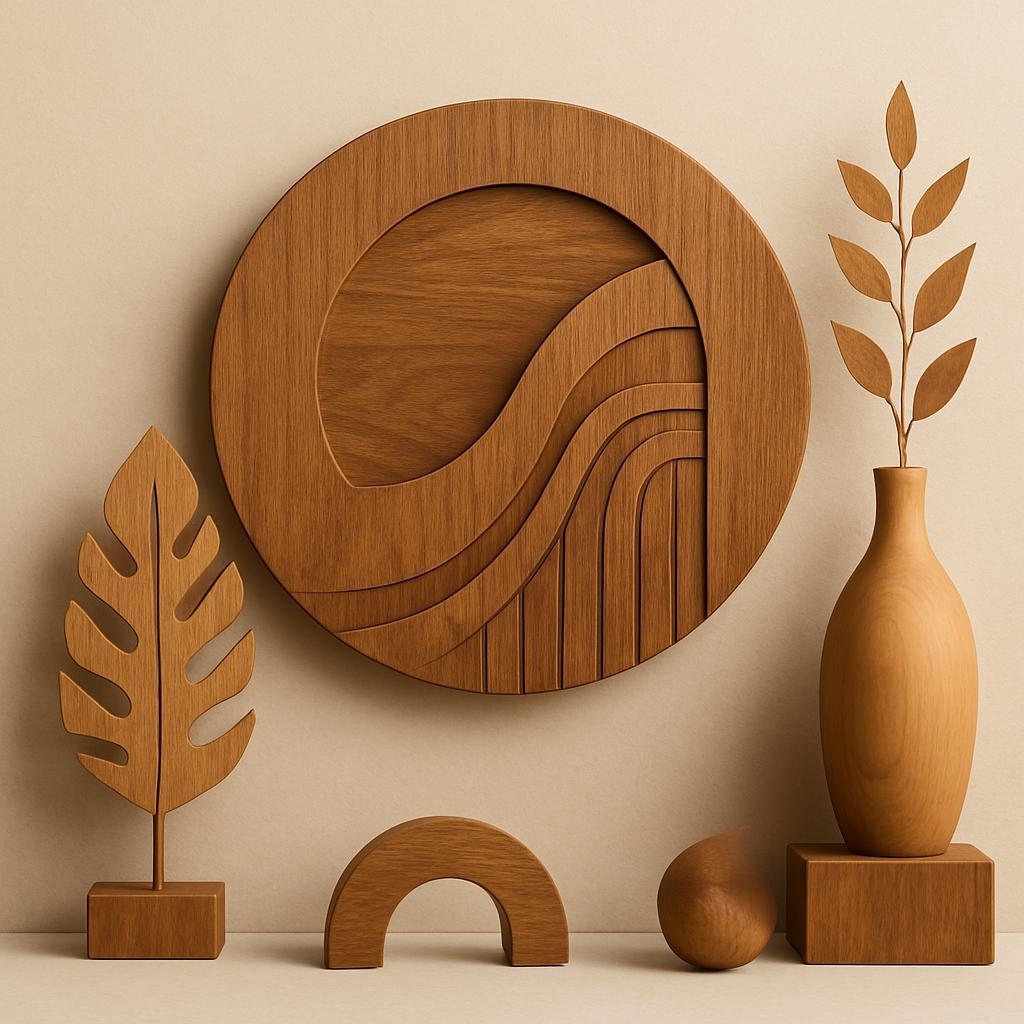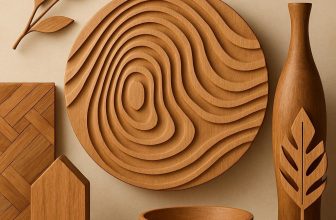
What if the simplest plank could transform your living room into a story told by grain and glow?
Handmade wood décor offers more than texture; it's a path for makers to practice patience, precision, and personal taste. For woodworking enthusiasts, these projects are both a test and a triumph-an invitation to push joinery, finish, and design ideas beyond generic store-bought pieces.
In this article you'll gain practical, doable paths: fresh project concepts, step-by-step approaches to construction and finishing, tips on wood choices and tool use, and strategies to match décor to your space while preserving the warmth of handmade craft.
Selecting the Ideal Wood for Handmade Wood Decor
Choosing the right wood sets the mood before you decide on a design. For handmade decor, stability is as critically important as color, so look for boards with minimal warping and a consistent grain that complements your piece. Consider where the item will live: a sunlit living room calls for woods that resist fading, while a humid bathroom demands moisture-amiable options. When possible, source from reputable suppliers who harvest responsibly; sustainable choices not only feel good but also help ensure a steady supply for future projects.
Different species offer distinct vibes and workability. Softwoods such as pine are forgiving,affordable,and excellent for rustic frames or wall signs,while hardwoods like maple,oak,and walnut provide durability and deeper color for pieces meant to endure.Consider grain pattern as well: a straight, fine grain finishes smoothly, but a bit of figure-like cathedral oak or quilted maple-can add character if the project suits that look. Above all, match the wood to the piece's scale and the finish you plan to apply.
| Species | Best For | Notes |
|---|---|---|
| Pine | Rustic frames, signs | Affordable, easy to work |
| Maple | Light-toned decor | Smooth finish, subtle grain |
| Oak | Durable panels, furniture accents | Prominent grain |
| Walnut | Statement pieces | Rich color, higher cost |
moisture and acclimation profoundly affect how your piece ages. Aim for a timber moisture content around 6-8% for indoor decor, and let new boards acclimate in the room where they will be used for 1-2 weeks before cutting. Check for uniform dryness,straightness,and minimal twists or cracks. If you're finishing the wood, plan a path that respects its density: softer woods respond well to oils and waxes, while denser species frequently enough take finishes evenly with a topcoat that guards against wear. take a moment to seal ends to curb checking on long planks.
Actionable selection tips at a glance: start with a versatile option like pine or poplar for practice pieces, then graduate to a showpiece in walnut or cherry as your confidence grows. Always verify provenance and storage conditions, and budget for a small amount of extra material to account for waste. plan your finish to enhance the wood's natural character-oil-based finishes for warmth, varnish or poly for durability, and a wax layer for a soft, tactile glow.with these checks in place, you'll transform simple boards into decor that feels designed and lasting.
Build Your Dream Workshop on a Budget →
Designing Statement Pieces That Transform Your Living Space
Statement pieces in handmade wood décor have a way of shaping a room's mood with a single, unmistakable gesture.When you select a piece that loves the space as much as you do-be it a dramatic live-edge console, a sculptural wall panel, or a stout pedestal-it becomes a visual destination that guides every other element. Start by assessing your room: note ceiling height, existing materials, and the color story you want to reinforce. A high-ceiling space welcomes tall, architectural forms; a cozy living area favors low, broad pieces that anchor the seating layout.
Design subtly but decisively by balancing bold grain with simple surroundings. Texture and contrast are your allies: a dark, richly grained wood can anchor a neutral space, while a lighter, open-grain piece brightens a muted palette.Pair strong wood with restrained metals or soft textiles to avoid visual competition. Consider finishes that suit daily life: matte oils for a natural look, hardwax for durability, or a protective matte varnish if the piece will see frequent use. to craft the story, define a focal point first, then let secondary décor echo its tone rather than replicate it.
To translate concept into practice, map out a few options and how they behave in the room. The following quick reference helps you imagine each piece's role before you commit:
| Piece | Ideal Room | Finish | Care |
|---|---|---|---|
| Live-edge dining table | Dining room or great room | hardwax oil | Dust, wipe spills; reoil annually |
| Wall-mounted panel | Living room or entry hall | Matte oil or satin varnish | Dust with microfiber; re-coat every 2-3 years |
| Geometric pedestal | Foyer or corner vignette | Clear matte finish | Avoid moisture; wipe with dry cloth |
bring it to life with placement and care. Position a console where natural light catches the grain, hang a panel at eye level to add texture without overpowering, or place a pedestal in a niche to create a quiet focal point. Lighting matters: warm 2700-3000K bulbs help amber tones bloom, while cooler temps emphasize modern silhouettes. Personal touches-engraving initials, inlays, or a subtle live-edge detail-make the piece uniquely yours. Rotate pieces seasonally or pair with textiles and greenery to maintain balance as your space evolves.
Build Your Dream Workshop on a Budget →
Finishing Techniques for Durable and Beautiful Wood Decor
Finishing is the final flourish that protects your piece and makes the grain sing. A thoughtful finish guards against moisture, fingerprints, and daily wear, while enhancing the wood's color and character. Start by testing your chosen product on a scrap or hidden spot, apply in thin coats, and let each layer cure fully before the next. This patient approach yields a durable, beautiful surface that ages gracefully.
Choosing the right finish depends on how the piece will be used and the wood you started with. Oil-based options, including tung or Danish oil, impart warmth and depth and are forgiving of uneven textures. Wax or wax-blend finishes give a silky feel and can be refreshed easily, though they wear faster in high-use areas. For everyday durability, water-based or oil-based polyurethane offers strong protection with options for a subtle, clear look. For a classic, warm glow with easier cleanup, shellac or varnish can be layered, but note their care requirements and UV behavior.
| Finish | Durability | Look & Feel | Cleanup |
|---|---|---|---|
| Tung oil / Danish oil | moderate-high | Rich, warm, natural | Wipe with lint-free cloth |
| Oil-based polyurethane | Very high | Amber-toned, durable | Mineral spirits |
| Water-based polyurethane | High | Clear, true color | soap & water |
| Wax / Beeswax | Low-moderate | Soft satin, tactile | Buff with cloth; reapply periodically |
A practical finishing routine you can follow:
- Prepare the surface: sand progressively to 320-400 grit and wipe away dust.
- Test the finish on a scrap to check color,sheen,and drying time.
- Apply thin coats, brushing or wiping in the direction of the grain; avoid puddles.
- Sand lightly between coats with 400-600 grit for a smoother final surface.
- Let each coat cure fully, then add 2-4 final coats for durability; seal edges last.
Maintenance after finishing is simple: dust with a soft cloth and avoid abrasive cleaners that can wear away the surface. Reapply wax or refresh with a light buff every year, and recoat polyurethane when you notice a gradual dullness or micro-scratches. Storing pieces out of direct sunlight helps preserve color and prevents premature aging.
Build Your Dream Workshop on a Budget →
Creative Ways to Display Handmade Wood Decor in Your Home
Warmth and character emerge when you display handmade wood decor with intention. Let the grain and patina guide your layout, balancing bold pieces with quieter accents. Choose a primary piece that sparks the room's mood, then echo its tones through textiles, ceramics, and greenery to create a cohesive scene.
Placement is where the magic happens.A low, wide shelf can anchor a grouping of carved bowls and keepsakes; a large wall panel becomes a focal point above seating; and a slim ladder or grid can turn multiple accents into a living gallery. Keep a consistent rhythm by varying height and spacing so nothing feels crowded.
| Display Method | Ideal Location | Quick Tip |
|---|---|---|
| Floating shelves | Eye level in living room | group in odd numbers for balance |
| Wall grid / ladder | hallway or stair wall | Rotate pieces seasonally |
| Coffee-table centerpiece | Center of living space | Protect with a shallow tray |
to make the wood glow, consider lighting and texture. Use soft, diffused light from a floor lamp or wall sconce to highlight grain without harsh glare. Pair wood with textiles like linen or wool for tactile contrast, and mix finishes to keep the display from feeling flat.
Rotate pieces to reflect seasons or room use, and protect surfaces with coasters or a shallow tray.Regular dusting and a quick, food-safe oil maintenance can keep the wood nourished while your display stays fresh and easy to live with.
Build Your Dream Workshop on a Budget →
Sustainable Sourcing and Budget friendly Wood Decor Projects
Smart sourcing starts with the wood that already exists in your space. Prioritize reclaimed or salvaged timber from demolition sites, old furniture, or discarded pallets. Seek local mills or suppliers that offer FSC-certified stock or certified reclaimed wood to ensure responsible harvesting and minimal environmental impact.When you purchase, ask about finishes, treatments, and the wood's age to choose options that are safe for living spaces and easier to maintain over time.
Budget-friendly projects shine when you combine creativity with practical sourcing. Start with small, high-impact pieces such as a gallery-style picture frame set, a floating plant shelf, or a wall-mounted organizer. Use scrap boards for edges and details, and opt for simple joinery like butt joints or discreet nails. Pick a non-toxic, low-VOC finish, such as a water-based polyurethane or a beeswax/mineral oil blend, to preserve the wood's natural warmth without harsh fumes.
To help visualize feasible options, consider the following quick-reference table that contrasts common sustainable sources with practical benefits and tips:
| Source | Benefits | Simple tip |
|---|---|---|
| Reclaimed pallets | Low cost, rustic character | Inspect for finish and nails; sand thoroughly |
| Salvaged timber | durability, story | Dry thoroughly; seal ends to reduce checks |
| Local FSC-certified wood | Consistent supply, accountability | Ask for straight-grain stock for easier cutting |
Quick-start checklist for sustainable, budget-friendly wood decor projects:
- Inventory scraps and measure potential pieces against your wall space.
- Choose one or two items to build first (frames, shelves, organizers).
- Source from reclaimed or FSC-certified suppliers and verify finishes are low-VOC.
- Use simple joinery and minimal hardware to keep costs down and results clean.
- Finish with a repair-friendly seal so the piece can be refreshed later.
Build Your Dream Workshop on a Budget →
Caring for Handmade wood Decor to Extend Its Life
Regular, gentle care keeps handmade wood décor looking vibrant for years. Start with a weekly dusting using a soft microfiber cloth to lift dust without scratching the surface. Wipe up spills promptly with a barely damp cloth, then dry immediately. Avoid soaking the wood or using abrasive or solvent-heavy cleaners, wich can dull finishes or alter the texture of carved details. For unfinished or lightly finished pieces, test any cleaner in a hidden corner first, and always follow the grain.
Conditioning works best when the piece is clean and dry.Apply a thin layer of mineral oil or a dedicated wood conditioner, following the grain, then wipe off any excess after a few minutes. Reapply every 6-12 months depending on humidity, use, and exposure to light. On waxed or oil-sealed surfaces,buff with a soft cloth to bring back luster; avoid layering heavy varnish on painted surfaces.
| Dust weekly | Use a soft microfiber cloth to lift dust without scratching |
| Wipe spills promptly | Blot with a dry cloth; avoid water saturation |
| Condition wood | Apply mineral oil or wood conditioner every 6-12 months |
| Inspect for damage | Check joints and finish monthly; address issues early |
Placement and environment play a big role in longevity. Keep pieces away from direct sunlight, heat vents, and radiators, where heat and UV light can fade or warp wood.Maintain indoor humidity in the 40-60% range; in dry rooms, a humidifier helps, while in damp spaces a dehumidifier or better airflow reduces swelling. Use felt pads on bases and coasters on surfaces to prevent scratches, and rotate seasonal pieces to distribute wear more evenly.
To make care effortless, create a simple care calendar and set gentle reminders. A quick monthly check can catch loose joints or finish wear early, while a few minutes of upkeep each week keeps pieces looking cohesive with your space. If you notice cracks or looseness, stop using the piece and consult a professional carpenter rather than attempting risky repairs yourself.
Build Your Dream Workshop on a Budget →
Q&A
What are some beginner-friendly handmade wood décor ideas to start with?
Begin with simple pieces such as wall shelves, carved coasters, or picture ledges. Sand, stain or seal to taste, and choose a finish that matches maintenance preferences. Pick pieces that fit your space and practical needs, keeping the scale in mind.
Which finishes or sealants work best for longevity and a natural look?
Water-based polyurethane or polycrylic provides a clear, durable layer without strong odor. Danish oil or tung oil enhances the grain and offers easy maintenance; wipe on, wipe off. For a softer, matte look, consider a wax over oil finish, then buff gently.
How can I integrate handmade wood décor into different rooms without clashing with existing furniture?
Start with a unifying element: similar wood tone, neutral finishes, or shared hardware across pieces.Vary scale and texture- Pair bold wall shelves with delicate coasters or carvings. Place larger pieces as focal points and use smaller accents to echo color or grain elsewhere.
What maintenance or care steps keep wooden décor looking fresh?
dust regularly and wipe with a damp cloth; avoid excess moisture. Refinish or reapply a protective coating every few years or when surfaces show wear. Store or display away from direct sun or humidity to prevent warping and fading.
Wrapping Up
Handmade wood décor reminds us that conversion begins with a single plank and a patient hand. The key takeaway is simple: thoughtful materials, measured planning, and a personal touch turn ordinary spaces into warm stories you can live in. For woodworking enthusiasts,this matters as craft builds skill,confidence,and a tangible connection to your surroundings-every notch,finish,and grain tells a part of the maker's journey. So, start small: try a tray, a wall shelf, or a carved accent; explore other guides; apply what you've learned to your next piece. step into your workspace with calm focus and let your space grow with you-there's real joy in what you create.







Absolutely love the unique charm of handmade wood décor! It adds such warmth and personality to any space.
I completely agree with Jill! Handmade wood pieces really bring a special touch to a home, making it feel more inviting and lived-in.
I couldn’t agree more! There’s something so timeless about handmade wood décor that truly elevates a room’s aesthetic and creates a cozy atmosphere.
I couldn’t have said it better myself! Handmade wood décor not only adds character but also tells a story, making every piece uniquely special and a conversation starter.
I totally resonate with all the comments here! Handmade wood décor not only enhances the beauty of a space but also brings an organic element that makes any room feel more alive and welcoming.
I couldn’t agree more with everyone! Handmade wood décor adds such a personal touch to your home, infusing it with warmth, uniqueness, and a sense of craftsmanship that mass-produced items just can’t match.
Absolutely! Handmade wood décor has an incredible way of blending functionality with artistry, turning everyday spaces into reflections of personal style and creativity.
I wholeheartedly agree with all the insights shared! Handmade wood décor not only showcases exceptional artisanship but also fosters a connection to nature, making our living spaces feel more intimate and inviting.
Absolutely love all the insights shared here! Handmade wood décor is truly a beautiful blend of nature and craftsmanship, elevating the ambiance of any space while adding warmth and a personal touch that makes it feel like home.
I completely echo the sentiments shared! There’s something truly special about handmade wood décor; it brings character and warmth to your living space, making it feel uniquely yours while celebrating the artistry of nature.
I’m with you all on this! There’s something magical about the uniqueness of handmade wood décor that not only enhances the beauty of our homes but also tells a story, making every piece a cherished addition to our living spaces.
I couldn’t agree more with everyone! Handmade wood décor truly embodies the essence of creativity and craftsmanship, adding not just beauty but also a sense of history and soul to our living spaces that mass-produced items simply can’t replicate.